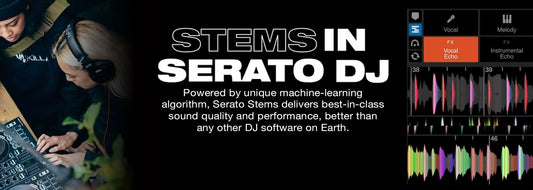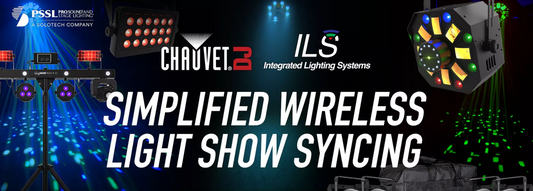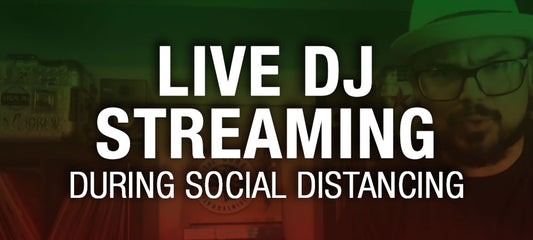Wireless DMX 101
Today we're going to be talking about wireless DMX solutions and some battery powered solutions. Wireless DMX is very different then infrared control, sometimes called IRC. Both of them share at the ability to transmit control wirelessly except they're very different. Infrared control will allow you to walk over to the light or be within 10 feet of it and control the various features that are proprietary to that light. This definitely offers some wireless control but it is not wireless DMX.
Wireless DMX
Wireless DMX is simply removing the cable from the control source and the cable from your lights. Let's first talk about some of the applications for wireless DMX. You could be doing an event in a large ballroom and you might have a 100 foot plus cable that runs that you have to do. You may even be hiding those cables with gaffer's tape, which means you can spend a lot of time on your hands and knees prepping for the show. With wireless solutions, I can simply have one transmitter at my control source and I could have wireless receivers on all my lights. What this means is that I'm eliminating the need of cable. In some cases I can actually have my wireless reception being received in another room.
The basic set up of a wireless DMX system
In a general wireless system you have a transmitter, which is usually connected to your control source - then you have a receiver, which is either plugged into your first light or from one light to another. The reciever receives the signal from the DMX transmitter. There's also something called a transceiver. A transceiver is a single unit that has the ability to either send or receive wireless DMX signal. These are handy in situations where you might need more than one transmitter or receiver.
How dependable is wireless DMX?
Just like with wireless microphones, the amount of investment that you make is generally going to yield more features. When it comes to wireless DMX, many of the more affordable options are going to have a fixed frequency. This means both the transmitter and receiving unit will have a fixed frequency that they're already set on. Generally the way this works is that you would have to press one button on the transmitter another button on the receiver to pair them. In most cases, he transmitter and receiving unit will remember it and you won't have to set it up again. There are some he transmitter and receiving units that allow you to dial in the frequency. I typically prefer that just so that I know that both the transmitter and the receiver already on the same frequency and I don't have to spend time trying to pair them up. There are also frequency agile (or frequency hopping) systems which means the wireless DMX system can actually hop from more than one frequency continually finding the strongest available channel and automatically eliminating the chance for interference. Frequency agile systems are definitely the preferred method. Just like anything else, you want the interference to be stopped before you even notice it.
Wireless and Wireless DMX
Often times you might hear the term "wireless" with respect to a light that has a battery built in. While that is technically "wireless" it is not "wireless DMX". Some of these lights do actually have a built-in rechargeable battery that eliminates the need to plug the light into the wall. This can save you a lot of time if you have lights that you set up and stay on one static color for most of the night. Remember these kind of lights are not "wireless DMX" they are simply wireless with respect to power.
Wireless DMX from Chauvet
There are some companies that have made fixtures that feature both wireless DMX and built in battery power. One example is Chauvet's FreedomPar Quad-5. This FreedomPar Quad-5 has both a rechargeable wireless battery and wireless DMX. It features RGBA 5 watt clusters along with the ability to position the light at an angle. Another offering from Chauvet is the FreedomPar RGBA. This is red, green, blue, and amber as well except they're using the ten millimeter diodes. You can see that both of these have the antenna sticking out. Continuing with the Chauvet line is the Freedom Strip Mini Quad 5, which is a linear wash fixture. This also features a rechargeable battery along witih five 5 watt RGBA options. Next from Chauvet is the Freedom Strip Mini RGBA featuring 10mm LED's along with a rechargeable battery.
Wireless DMX from American DJ
The WiFLY Bar RGBA is a great offering for a linear wash from American DJ which features ten millimeter red, green, blue, and amber LED's. It also has a built-in battery. This is a great addition for anyone who's wanting to wash a wide section with a single bar without any wires. American DJ also offers a light with five 5 watt RGBA clusters called the WiFLY Par QA5. This is wireless DMX and has a rechargeable battery. The battery on this unit is actually removable and can be replaced over time. American DJ also has a wash called the WiFLY Bar QA5 which has wireless DMX functionalitly and a replaceable rechargeable battery. American DJ's ultra lightweight Wifly Wash Bar has a 120 degree beam angle which works excellent for putting underneath your DJ table, behind your DJ facade, and washing the whole facade or table without having any hot spots.
Transmitters and Other Options
Some of the lights we looked at have the transmitters already built in. If you have a light that doesn't have this feature built-in, you can still use wireless DMX. For instance, Chauvet's D-Fi Duo RX and TX system comes complete with the transmitter and receiver. With this unit, each of them do require their own power and they will need to be synched together as they are a fixed frequency. This is a very affordable and dependable option. The D-Fi 2.4 gigahertz is an excellent option for a transiever. This has the option to either auto synch or you can dial in the frequency to be paired up with another unit. This unit will send and receive wireless DMX. American DJ's Wifly D6 Branch is a Wifly receiver but it's also a splitter built in one. What this means is that you could simply plug this into your truss rig and you can send your DMX chains out from here. This is a six way splitter that will receive wireless DMX from a Wifly transmitter. It is very light and very compact - it is a must have for anyone who has a truss rig.
Wireless DMX Controllers
The American DJ Wifly RGBW8C is a very user-friendly control that has the transmitter built in. This unit allows you to actually have it sitting at your desk or your DJ booth while it's transmitting to any one of your Wifly-enabled fixtures. This eliminates cables altogether. It features 8 channels of control, built in color features, as well as some built in presets on board. Chauvet's also has a wireless controller available called the Obey 4 D-Fi 2.4. This unit is a 2.4 gigahertz wireless transmitter built inside an Obey 4 controller.
W-DMX
W-DMX is a proprietary protocol that's actually been developed by a company called Wireless Solutions in Sweden. This has become the professional standard for wireless DMX for large concerts and large productions. One thing to keep in mind when purchasing W-DMX products is that they are not proprietary to the manufacture they actually uses them. For example, both Chauvet's WDMX-TRANS and Elation's EWDMX employee the W-DMX wireless protocol. Then take it one step further - Elation offers the PLATINUM-SPOT-5R-PRO which is eliminating cables for a large production. The PLATINUM-SPOT-5R-PRO uses W-DMX so it will receive signal from any W-DMX transmitter. In terms of production, this means you can have an extremely large stage of 80 or more lights, all being controlled using W-DMX.
We've gone over a lot of wireless solutions including Wifly, D-Fi, W-DMX, and much more. It can be a lot of information to soak up so feel free to watch the video a few times to make sure that you get it all. The best part is that here at ProSound and Stage Lighting, our sales advisors have been educated on all of the different types of wireless systems out there. We won't let you make the mistake of buying a proprietary wireless signal that may not work with another. For more wireless solutions that are available to you, feel free to chat, email, or call 1-800-268-5520 with any questions you may have.




